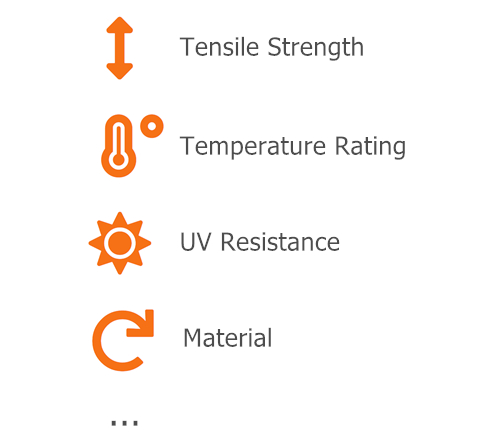Choosing the right nylon cable ties for your application is critical to ensure that they provide the necessary strength and durability. Here are some factors and specifications to consider when selecting nylon cable ties:
1 Tensile strength:
The tensile strength of a nylon cable tie refers to the maximum force that can be applied to the cable tie before it breaks. Tensile strengths can range from a few pounds to several hundred pounds, depending on the size and design of the cable tie.
You’ll need to select a cable tie with a sufficient tensile strength to hold the weight of the items you plan to secure. The tensile strength is usually listed in pounds or kilograms in the product specifications. Be sure to select a cable tie with a sufficient tensile strength for your application.
check our cable ties size chart to find the tensile strength for every single size in pounds (lb) and kilograms (kg).
2 Temperature rating:
Nylon cable ties typically have a temperature rating that ranges from -40°C (-40°F) to 85°C (185°F), although this can vary depending on the specific type of nylon material used and the manufacturer’s specifications.
It’s important to note that the temperature rating of a nylon cable tie refers to the maximum temperature that the cable tie can withstand without degrading or losing its strength. If a cable tie is exposed to temperatures that exceed its rated temperature range, it can become brittle and break or lose its tensile strength, which can compromise the integrity of the installation.
If the application involves exposure to high temperatures, it may be necessary to choose a cable tie that is specifically designed for high-temperature environments.
Check our heat stabilized nylon cable tie for heat resistant and continuous or extended exposure to high temperatures (up to 120℃) environments.
3 UV resistance:
UV stabilized nylon cable ties are cable ties that are specially designed to resist the damaging effects of ultraviolet (UV) radiation from the sun. Over time, exposure to UV radiation can cause standard nylon cable ties to become brittle and break, which can compromise the integrity of the installation.
If you will be using cable ties in outdoor environments, be sure to select a cable tie with UV resistance to prevent degradation from prolonged exposure to sunlight.
4 Material:
Nylon cable ties are typically made from nylon 6/6, which is a type of polyamide material that is strong, durable, and resistant to heat, moisture and chemicals.
Nylon is a popular choice for cable ties because it has a high tensile strength, which makes it capable of withstanding significant pulling forces without breaking or degrading. Additionally, nylon is relatively inexpensive and easy to manufacture, which makes it a cost-effective option for cable tie production.
5 Length and width:
Select a cable tie with the appropriate length and width for your application.
Nylon cable ties are available in a range of lengths, from a few inches to several feet long. The length of the cable tie needed will depend on the application and the size of the bundle or object being secured.
The width of a nylon cable tie typically ranges from 2.5mm to 12mm, with wider cable ties providing greater strength and durability.
6 Color:
Nylon cable ties are available in a wide range of colors, including white, black, red, blue, green, yellow, and more. The color of the cable tie can be chosen based on aesthetic preferences or to help with identification or organization.
By considering these factors and specifications, you can select the right nylon cable ties for your application and ensure that they provide the necessary strength, durability and safety.

